After becoming an integral part of the home early in the twentieth century, the bathroom has undergone many changes and experienced many design trends. Some reflect changes in lifestyles, while others came about with the development of new materials, products, and processes. Knowledge of these trends would be useful when renovating a bathroom in an older/historic home where keeping to the period design is important. Following is a summary, by decade, of select bathroom design trends.
Bathroom Design Trends by Decade
Early 1900s
• Bathroom design was moving away from the lavish toward the convenient, family-style bathroom.
• A concern for sanitation and hygiene was paramount in bathroom design.
• An emphasis on maintenance and safety emerged, with consumers demanding products and materials that were easy to clean.
• Everything came in white, presenting the "antiseptic" look.
• Cabinetry was not popular because exposed pipes were considered more sanitary and easier to repair.
•
 |
 |
A claw-foot tub (see Figure 1.6), pedestal lavatory, and water closet with an elevated tank made up the standard three-piece bathroom.
• If the home had electricity, lighting most likely consisted of a shadeless, clear bulb, usually hanging from the center ceiling on a cloth-covered cord.
• The cage shower was introduced as a single shower fixture.
1920s
• Sanitary plumbing was so widespread among the middle and upper class that attention turned to aesthetic considerations.
• The shower became common in the home.
• The closed-in, rectangular porcelain tub replaced the claw-foot tub (see Figure 1.7).
• Faucets and shower controls lined up vertically under the showerhead.
•
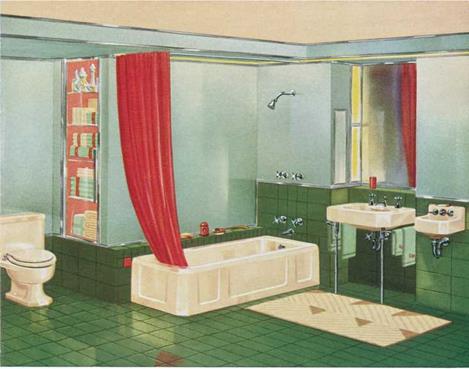 |
Pedestal lavatories were popular, as well as console lavatories supported by metal legs.
A FOUR-FIX Т1ЫГР BATHROOM^ BUILT AROUND THE NEW BATH
One of the most interesting details of this colorful room is the new Kohler Cosmopolitan.. . the bath with flatter bottom, wider rim, lower sides, K-554-CV. Other matched fixtures which make up the foursome are the Claridge vitreous china lavatory, K-4946-F; Walcot vitreous china dental lavatory, K-5360-BA; quiet-performing siphon jet Integra
 |
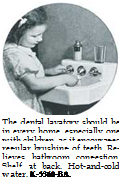 |
closet, K-5580-A. The Kohler color is Tuscan.
|
The bathroom above measures 12’xll’ 4". Floor and wainscot are 6"xl2" glazed tile. Upper walls are sand blasted plate glass. Glass linen cabinet doors. Indirect lighting above the tub and in lavatory recess. Plaster ceiling is painted.
|
• Lavatories were often made of Monel, a corrosive-resistant, light-weight, white metal containing a mix of copper and nickel.
• Nickel was used for bright work on faucets.
• Hand-painted murals, mirrors, and cloth were common surface coverings for walls.
• White was still popular, but porcelain made it possible to add color.
• The color matching of vitreous china glazes and cast iron enamels was perfected.
• Although black fixtures appeared, they would not be popular on the market for four decades.
• Colors included blue, green, ivory, yellow (see Figure 1.7), brown, lavender, and gray.
•
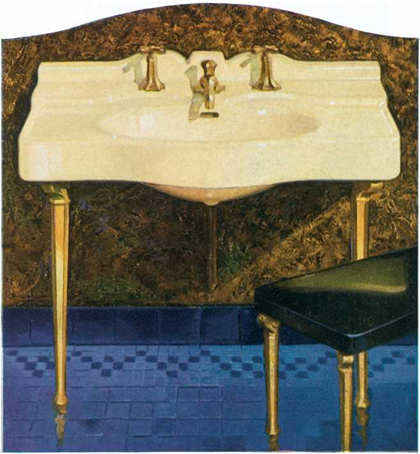 |
Dressing table vanities were featured as more activities moved into the bathroom space (see Figure 1.8).
Kohler Bellaires Lavatory K-4915
|
A |
N artistic triumph in vitreous china is the Kohler Bellaires lavatory. A. monument to the skill and craftsmanship of the Kohler artisans. The broad, massive slab is cast in one piece. The graceful curving back, the slightly raised shelf, the spacious tablelike end portions and generous bowl combine to give this boudoir lavatory a beauty, utility, and appeal never before approached.
The fittings, like two shining obelisks, are dainty and lovely with their coating of shining gold. Yet they are sturdy, and efficient as well.

 |
The finely sculptured legs are cast of fine metal. They have all the grace found in fine furniture. Placed far apart, they allow the use of a dressing table bench such as is shown in the above illustration.
• The bathroom continued to be viewed as a functional space, not for relaxation.
• Lighting consisted of a center ceiling lamp surrounded by milk-glass diffusers of various shapes.
• The first copper plumbing systems were installed late in the decade.
1930s
• The bathroom began to resemble the rest of the house with comfort emphasized.
• Small lavatories called dental lavatories were marketed as a means to help children practice dental hygiene.
• The four-fixture bathroom was now common—tub/shower, lavatory, dental lavatory, and toilet.
• Wall-hung lavatories were shown, along with lavatories supported by metal posts that included towel bars on the sides.
• Disappearing steps were incorporated to help children reach the lavatory.
• The leak-proof, one-piece shower was developed.
• Pedestal lavatories were common.
• Late in the decade, plumbing was hidden and fixtures were compartmentalized.
• Ads showed Americans how to design unused space (under stairs, dormer rooms, or large closets) into small bathrooms Kohler named the "lavette." (See Figure 1.9)
• Plans were available to show homeowners how to convert underused space to a bathroom.
• Although introduced in 1893, glass block was now heavily promoted for residential buildings.
• Bathrooms were lit by a single, flush-mounted ceiling fixture in the center of the room, which remained the norm until the 1970s.
• The influence of the Arts and Crafts Movement introduced more colors into the bathroom. 1940s
• New colors, such as rouge (burgundy), Tuscan (gold), and spring green (light green), as well as pink (see Figure 1.10) and bright blue, emerged.
• By the mid-1940s, the dental lavatory disappeared from ads.
• The single, mixing lever for showers was now available.
• The bench bath allowed parents to sit on the edge to watch children as they bathed (see Figure 1.11).
• Smaller bathtubs were designed for smaller bathrooms (see Figure 1.12).
• Laminates, mirrored walls, glass counters, and cork floors were trendy.
• Chromium experienced widespread use, followed by silver plate and gold plate.
• Linoleum replaced the white tile look and added color to the floor.
• Plastic appeared in fixtures.
• Glass block continued its popularity.
• Stainless steel became popular for lavatories and countertops.
• Small appliances, like hair dryers, entered the bathroom.
1950s
• Most new innovations came in the way of new materials.
• The 4 ft x 4 ft (1.2 m x 1.2 m) tub/shower became a solution for small spaces.
• Lavatory cabinets were common (see Figure 1.13).
• The term "powder room" was beginning to be used.
• New innovations in the bathroom included a telescoping towel bar; ceiling fixtures with a light, heater, and fan; adjustable showers; and an electric heated towel bar.
• The plastic tub with glass fibers was patented.
• Pink and gray were popular colors.
• Stainless steel remained popular for lavatories and countertops.
1960s
• The idea of relaxation was finally coming back to the bathroom.
• Ads portrayed hometown girls and happy moms relaxing in the bathroom.
• Bold colors emerged (see Figure 1.14), including orange, bright yellow, deep red, dark brown, and dark green, as well as the colors so distinctive of the era—avocado green and harvest gold.
OTHER LAVATORIES EOR THE LAVETTE
Top: THE GRAMERCY. The 4 >/2" wide shelf at back is a "natural" for the Lavette. Holds powder puff and powder, cream and soap, and other accessories used in a first-floor washroom. Vitreous china, beautifully proportioned. Hot-and-cold water fitting is not in your way. Pop-up drain. 3 back. Trap and supplies with stops. Size 22"xl8", K-4964-BA.
Center: THE NAROBOL. This lavatory is meant for small Lav – ettes where space is at a premium. Projects only 14" from wall and is 26" long. Back is 5 Z2" high. Glistening enameled cast iron. Hot and cold, chromium plated faucets. Supplies and trap. Roomy basin. K-604-M.
 |
 |
||
Bottom: THE HUDSON. Its modem lines, beveled corners, and flat surfaces make this lavatory look expensive. And yet it isn’t. Smooth, glossy, enamel cast iron. The compact Centra hot-and-cold water fitting leaves plenty of unobstructed space on the slab. Trap and supply pipes with stops. Metal parts are chromium plated. 6-inch high back. Size 20"xl8", K-226-CA.
• New bathrooms were more luxurious and second bathrooms were promoted.
• The new self-rimming lavatory was incorporated into the vanity.
• The California hot tub and backyard pool were popularized.
• The claw-foot tub disappeared.
1970s
• Multiperson tubs for group soaks were popular.
• Hydromassage tubs, such as the whirlpool tub, were developed.
• New colors included sand, gray, black, and pink.
• Colored fixtures were an important part of the bathroom design.
• The double lavatory became an important selling point in new homes.
• The nostalgic look reappeared in a vintage toilet with elevated tank and chain pull, the ball-and – claw-foot tub, and pedestal lavatory.
The problem of the two-door bathroom is here solved by grouping the fixtures closely, with all hot water outlets on the same inside wall to save on piping and protect from freezing. A Kohler Compact radiator, recessed under the window to meet cold as it enters, keeps the bathroom comfortably warm.
![]()
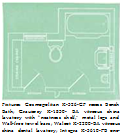
![]()
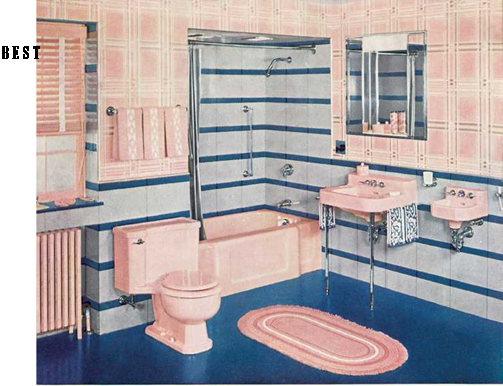 |
|
A true recess with dropped ceiling, lighted from above and faced with Vitrolite to ceiling height, focuses importance on the tub. Vitrolite continues around the room as a wainscot, drawing the other fixtures into the picture. Above the wainscot the walls are wallpaper, in which is repeated the Teachblow of the fixtures.
• Theme designs were shown for the bathroom, including the patriotic, desert Southwest, and Caribbean motifs.
• Solid surface countertops with integral lavatory were developed in 1968, but were not introduced to the builder market until 1971. Four colors were available.
• Later in the decade, bathrooms were becoming a place of leisure with larger tubs for relaxation.
• Homeowners switched to fluorescent lamps to save energy, and to track lighting to increase the amount of light.
1980s
• Bathrooms increased greatly in size.
• Softer pastel colors returned.




